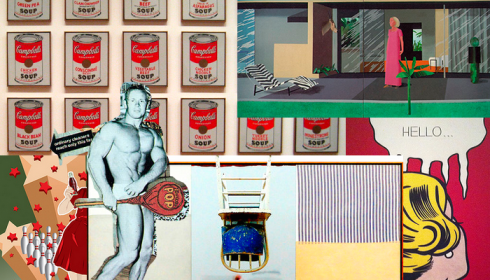 Our solutions team carved out some time to visit International Pop—the Walker Art Center’s exhibition chronicling the global rise of Pop art between the 1950s and ‘70s.
Our solutions team carved out some time to visit International Pop—the Walker Art Center’s exhibition chronicling the global rise of Pop art between the 1950s and ‘70s.
As a response to society’s newfound postwar consumerism, Pop was a movement that incorporated everyday objects—especially the shiny and the consumable, like food, television, comics, glossies and tabloids.
No art form or media exists in a vacuum, so we’ve taken it as an exercise to dig into some of the fundamentals of Pop art to offer some principles to incorporate into the digital realm. Here we go:
Accessibility Is Sovereign
As a reaction to (what many considered to be) pretentious, overworked Abstract Expressionism, Pop offered straightforward depictions of the common and the accessible. Gretchen Berg recorded Andy Warhol saying, “Pop artists did images that anybody walking down the street could recognize in a split second…all the great modern things that the Abstract Expressionists tried so hard not to notice at all.”
Pop introduced art into daily life and to new audiences. “High art” was no longer linked with only wealth, prestige or prosperity. Looking at digital concerns today, there are accessibility initiatives around the globe to bring broadband to rural areas and reduce costs for economically disadvantaged individuals. In addition, compliance standards like timed response alerts and assistive technology like screen readers help ensure digital content is available to all.
And from a strategy perspective: removing friction and barriers to your content (such as forced signups or laborious jargon) does more than improve downloads and encourage engagement: it also builds trust in your brand.
Challenge Convention—Take Tradition to Trial
Pop art was considered a youthful, optimistic movement. It was also seen as aggressively defiant of Art—as the traditional gatekeeping establishment with the role of representing and upholding culture and society’s most esteemed (and often elite) ideals. That’s a fine balance to strike. Perhaps disillusionment was the catalyst, but in popular culture and the art world, change—not cynicism—was the byproduct.
It’s a reminder to our industry to continue challenging conventions. To continue asking why we do the things we do—is there a better way? Best practices are only best practices until something better comes along. We recently wrote about some of our key takeaways from SXSW, including our ongoing responsibility to adapt design innovations to how humans actually live and interact with technology and their environment. Here’s the payoff:
If Pop art made the claim that anything could be art, today’s finest IT and UX professionals are dictating that anything can be an interface. That interface can serve as a tool for change, and it should be available to all.